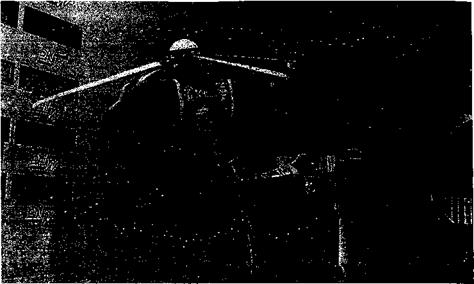Role of Wind Tfinnels in Aerodynamic Design
Wind tunnel testing of subscale rotors and airframes is an important technique for estimating the performance of full-size helicopters. The various techniques are discussed by Harris (1973) and Philippe (1990). Wind tunnel tests allow good estimates of rotor thrust and airframe drag and also help to design out complicated effects prior to first flight, including any adverse rotor-airframe interactional effects – see Chapter 11. To reduce Reynolds number uncertainties and minimize risk, large – or full-scale testing is desirable – see also Section 7.3.4. While the wind tunnel testing of a full-scale rotor or a complete helicopter is an enormously expensive and time consuming undertaking, it can be much less expensive than remedying a persistent problem after the helicopter has flown. Wind tunnel testing with close to full-scale rotors gives the analyst the opportunity to measure results exactly as they would be found on the actual helicopter, without the uncertainties of Reynolds number or other issues that would be apparent on subscale models. Yet very few wind tunnels in the world are capable of full-scale or large subscale rotor experiments. Full-scale rotors are routinely tested on hover towers by helicopter manufacturers, but this gives only limited knowledge of their overall performance.
The need for measurements of rotor thrust and power is essential in any model test, these usually being obtained using strain-gauge balances. The use of blade and airframe instrumentation for on – and off-surface measurements are usually a goal in either hover or wind tunnel testing, although such data are not always available simultaneously from any one tunnel entry. The issues of repeatability of the test conditions and rotor operating state then become a concern. The difficulties in obtaining off-surface measurements in the wake of the rotor cannot be underestimated (see Chapter 10), and for comprehensive tests on large or full-scale rotors, this often requires an international effort by specialists from several organizations. As a consequence, most helicopter rotor and rotor-airframe testing has been done at a smaller scale, which may range from 1/4 to 1/8 scale. Such tests are often on simpler and more generic airframe configurations, perhaps with aeroelastically stiff (rigid) blades to better isolate specific interactional aerodynamic phenomena – see Chapter 11. This gives the analyst the best opportunity to precisely define the geometry of the problem and to study the flow physics of specific phenomena with greater confidence. These tests can provide the analyst with a comprehensive data suite of on – and off-surface measurements (along with estimates of tunnel wall interference effects), and so are ideally suited for the validation of computational models of the flow field. Unfortunately, few tests have provided coincident measurements of on-surface loads and off-surface flow properties, and the lack of such data continues to impede the validation of computational aerodynamic models.
The testing of geometrically and aeroelastically scaled rotor models gives much information about the actual capabilities of the full-scale rotor system. Combined with geometrically scaled airframe models such as that shown in Fig. 6.28, the net system performance can be measured to a high level of fidelity and the measurements used confidently to validate various levels of performance predictions. Despite the enormous costs, pressure measurements on the blade surface are extremely useful for the validation of comprehensive rotor analyses. This helps gain better confidence levels in these analyses for use in the design of future rotors. However, the complications of elastic blade deformations on the full-size helicopter makes it difficult to isolate specific aerodynamic phenomena, and such tests are
|
Figure 6.28 A geometrically scaled rotor and airframe of the NH-90 helicopter tested in a large wind tunnel. |
less useful for generating high-fidelity measurements that can be used for the validation of flow models. As better Navier-Stokes-based CFD methods and turbulence models become increasingly capable and reliable, the role of wind tunnel testing on larger scale rotor configurations must clearly shift back toward the generation of high-fidelity measurements on simpler configurations but at close to full-scale flight Reynolds numbers. In this regard, the closure (or constant threat of) of large subsonic wind tunnels suitable for helicopter studies continues to be a major concern to both the research and manufacturing community.















